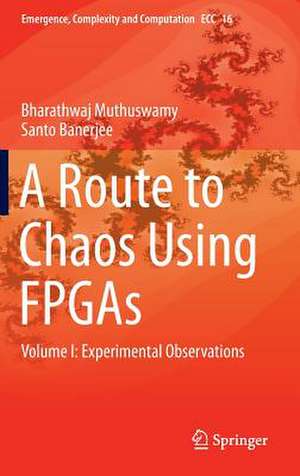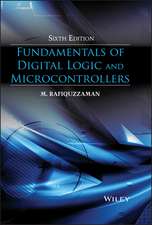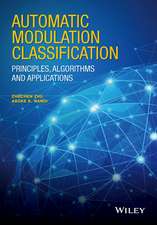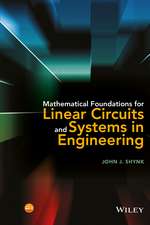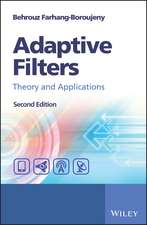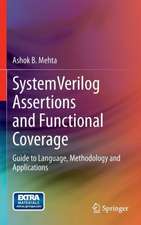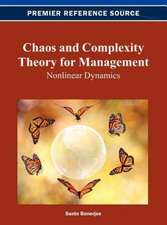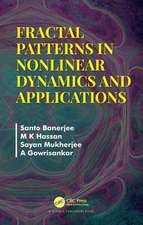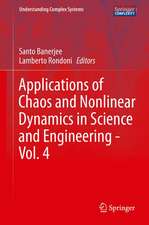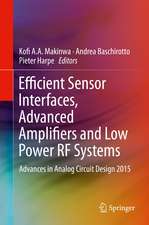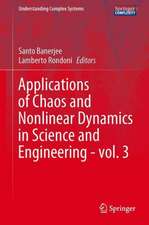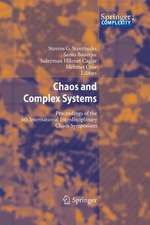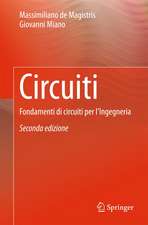A Route to Chaos Using FPGAs: Volume I: Experimental Observations: Emergence, Complexity and Computation, cartea 16
Autor Bharathwaj Muthuswamy, Santo Banerjeeen Limba Engleză Hardback – 27 iun 2015
As such, it differs from other texts on chaos: first, it puts emphasis on combining theoretical methods, simulation tools and physical realization to help the reader gain an intuitive understanding of the properties of chaotic systems. Second, the "medium" used for physical realization is the FPGA. These devices are massively parallel architectures that can be configured to realize a variety of logic functions. Hence, FPGAs can be configured to emulate systems of differential equations.
Nevertheless maximizing the capabilities of an FPGA requires the user to understand the underlying hardware and also FPGA design software. This is achieved by the third distinctive feature of this book: a lab component in each chapter. Here, readers are asked to experiment with computer simulations and FPGA designs, to further their understanding of concepts covered in the book.
This text is intended for graduate students in science and engineering interested in exploring implementation of nonlinear dynamical (chaotic) systems on FPGAs.
| Toate formatele și edițiile | Preț | Express |
|---|---|---|
| Paperback (1) | 385.08 lei 43-57 zile | |
| Springer International Publishing – 17 oct 2016 | 385.08 lei 43-57 zile | |
| Hardback (1) | 392.37 lei 43-57 zile | |
| Springer International Publishing – 27 iun 2015 | 392.37 lei 43-57 zile |
Din seria Emergence, Complexity and Computation
- 8%
 Preț: 397.83 lei
Preț: 397.83 lei - 18%
 Preț: 1132.65 lei
Preț: 1132.65 lei - 18%
 Preț: 946.72 lei
Preț: 946.72 lei - 20%
 Preț: 651.75 lei
Preț: 651.75 lei - 20%
 Preț: 570.97 lei
Preț: 570.97 lei - 15%
 Preț: 653.33 lei
Preț: 653.33 lei - 15%
 Preț: 648.24 lei
Preț: 648.24 lei - 15%
 Preț: 651.19 lei
Preț: 651.19 lei - 20%
 Preț: 940.98 lei
Preț: 940.98 lei - 15%
 Preț: 647.59 lei
Preț: 647.59 lei - 15%
 Preț: 641.71 lei
Preț: 641.71 lei - 15%
 Preț: 645.28 lei
Preț: 645.28 lei - 15%
 Preț: 649.06 lei
Preț: 649.06 lei - 18%
 Preț: 1415.22 lei
Preț: 1415.22 lei - 20%
 Preț: 1304.44 lei
Preț: 1304.44 lei - 20%
 Preț: 1296.18 lei
Preț: 1296.18 lei - 20%
 Preț: 655.35 lei
Preț: 655.35 lei - 15%
 Preț: 648.56 lei
Preț: 648.56 lei - 18%
 Preț: 953.82 lei
Preț: 953.82 lei - 20%
 Preț: 657.02 lei
Preț: 657.02 lei - 18%
 Preț: 1117.03 lei
Preț: 1117.03 lei - 20%
 Preț: 992.26 lei
Preț: 992.26 lei - 15%
 Preț: 656.74 lei
Preț: 656.74 lei - 20%
 Preț: 649.60 lei
Preț: 649.60 lei - 15%
 Preț: 654.43 lei
Preț: 654.43 lei - 20%
 Preț: 661.14 lei
Preț: 661.14 lei - 20%
 Preț: 645.47 lei
Preț: 645.47 lei - 20%
 Preț: 658.19 lei
Preț: 658.19 lei - 20%
 Preț: 644.15 lei
Preț: 644.15 lei - 18%
 Preț: 880.77 lei
Preț: 880.77 lei - 20%
 Preț: 1455.75 lei
Preț: 1455.75 lei - 20%
 Preț: 1158.26 lei
Preț: 1158.26 lei
Preț: 392.37 lei
Nou
Puncte Express: 589
Preț estimativ în valută:
75.10€ • 81.61$ • 63.13£
75.10€ • 81.61$ • 63.13£
Carte tipărită la comandă
Livrare economică 21 aprilie-05 mai
Preluare comenzi: 021 569.72.76
Specificații
ISBN-13: 9783319181042
ISBN-10: 3319181041
Pagini: 225
Ilustrații: XXIII, 219 p. 131 illus.
Dimensiuni: 155 x 235 x 20 mm
Greutate: 0.52 kg
Ediția:2015
Editura: Springer International Publishing
Colecția Springer
Seria Emergence, Complexity and Computation
Locul publicării:Cham, Switzerland
ISBN-10: 3319181041
Pagini: 225
Ilustrații: XXIII, 219 p. 131 illus.
Dimensiuni: 155 x 235 x 20 mm
Greutate: 0.52 kg
Ediția:2015
Editura: Springer International Publishing
Colecția Springer
Seria Emergence, Complexity and Computation
Locul publicării:Cham, Switzerland
Public țintă
GraduateCuprins
Introduction.- Designing Hardware for FPGAs.- Chaotic ODEs: FPGA Examples.- Bifurcations.- Chaotic DDEs: FPGA Examples and Synchronization Applications.- Introduction to MATLAB and Simulink.- Chapter 1 MATLAB Code.- Chapter 2 VHDL, Simulink DSP Builder and SDC File.- Chapter 3 VHDL, MATLAB Code and ModelSim Scripts.- Chapter 4 MATLAB Code, VHDL and ModelSim Scripts.- Chapter 5 VHDL.- Glossary- Solutions.
Notă biografică
Santo Banerjee was a senior research associate in the department of Mathematics, Politecnico di Torino, Italy from 2009-2011. Currently he is working as an Associate Professor, in the Institute for Mathematical Research (INSPEM), University Putra Malaysia, Malaysia, and is also a founder member of the Malaysia-Italy Centre of Excellence in Mathematical Science, UPM, Malaysia. His research is mainly concerned with Nonlinear Dynamics, Chaos, Complexity and Secure Communication. He has published 16 books and over 90 research articles in international journals in the field. Currently he is involved in many academic and industry projects on signal processing, biomedical measures and devices, complex networks and cryptography. He is an editor of EPJ Plus (Springer) and other journals publishing both regular and special issues. For more
detail, please visit https://sites.google.com/site/santobanhome/ .
detail, please visit https://sites.google.com/site/santobanhome/ .
Dr. Muthuswamy's research interests are investigating the chaotic dynamics of the Muthuswamy-Chua system, understanding properties of physical memristors such as discharge tubes and studying applications of nonlinear dynamical systems using field-programmable gate arrays.
He has held visiting professor appointments at the University of California, Berkeley; Vellore Institute of Technology and the University of Western Australia.
Textul de pe ultima copertă
The purpose of this introductory book is to couple the teaching of chaotic circuit and systems theory with the use of field programmable gate arrays (FPGAs).
As such, it differs from other texts on chaos: first, it puts emphasis on combining theoretical methods, simulation tools and physical realization to help the reader gain an intuitive understanding of the properties of chaotic systems. Second, the "medium" used for physical realization is the FPGA. These devices are massively parallel architectures that can be configured to realize a variety of logic functions. Hence, FPGAs can be configured to emulate systems of differential equations.
Nevertheless maximizing the capabilities of an FPGA requires the user to understand the underlying hardware and also FPGA design software. This is achieved by the third distinctive feature of this book: a lab component in each chapter. Here, readers are asked to experiment with computer simulations and FPGA designs, to further their understanding of concepts covered in the book.
This text is intended for graduate students in science and engineering interested in exploring implementation of nonlinear dynamical (chaotic) systems on FPGAs.
As such, it differs from other texts on chaos: first, it puts emphasis on combining theoretical methods, simulation tools and physical realization to help the reader gain an intuitive understanding of the properties of chaotic systems. Second, the "medium" used for physical realization is the FPGA. These devices are massively parallel architectures that can be configured to realize a variety of logic functions. Hence, FPGAs can be configured to emulate systems of differential equations.
Nevertheless maximizing the capabilities of an FPGA requires the user to understand the underlying hardware and also FPGA design software. This is achieved by the third distinctive feature of this book: a lab component in each chapter. Here, readers are asked to experiment with computer simulations and FPGA designs, to further their understanding of concepts covered in the book.
This text is intended for graduate students in science and engineering interested in exploring implementation of nonlinear dynamical (chaotic) systems on FPGAs.
Caracteristici
Course-tested introduction to this field Contains many worked examples Companion website includes videos with problem-solving sessions Includes supplementary material: sn.pub/extras
